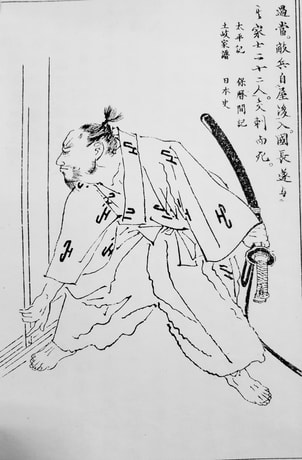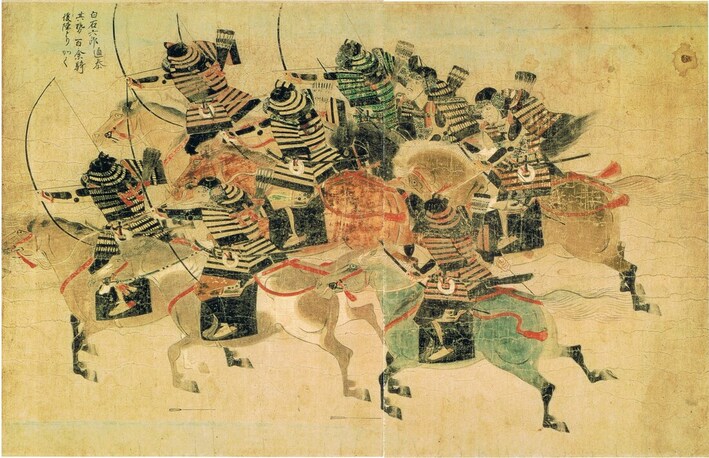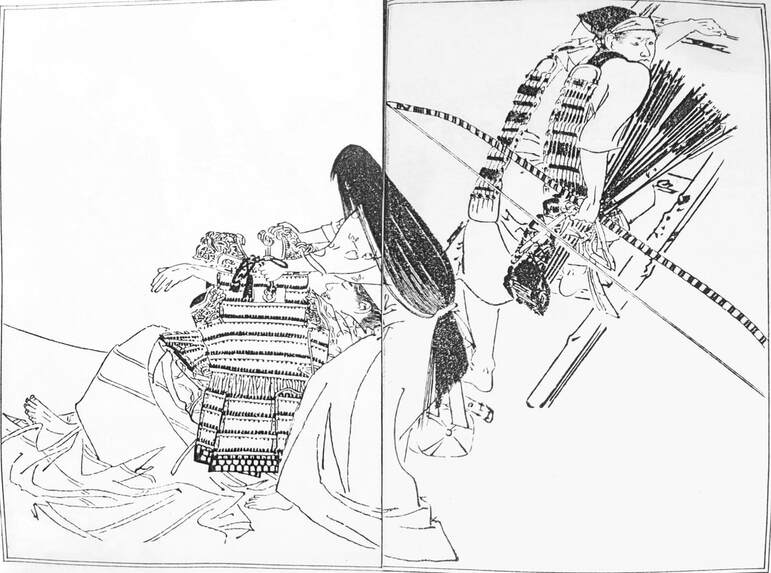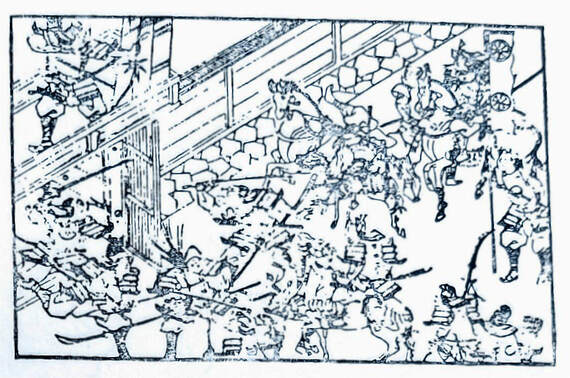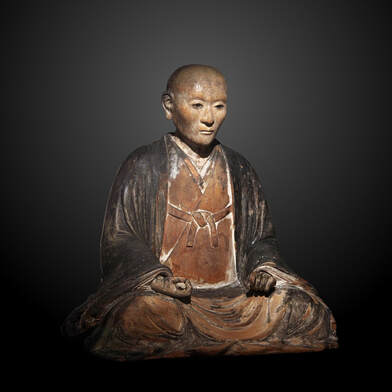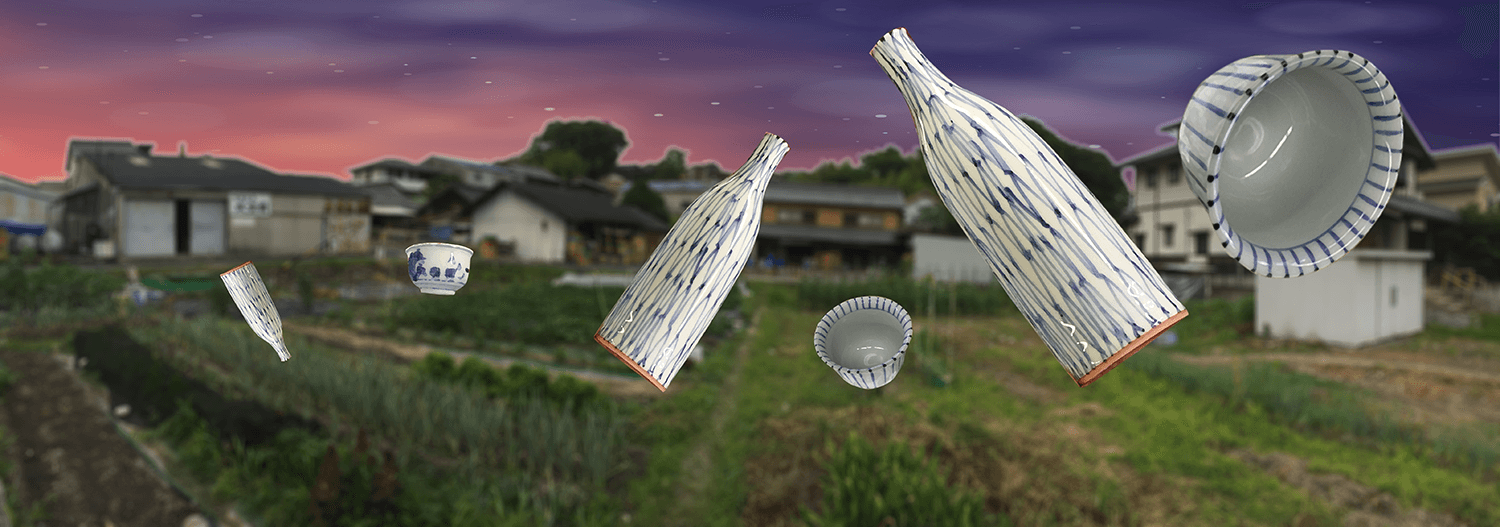by Hans O. Karlsson
Background
The year of the rat (甲子) is the first year in the 60-year cycle of the Chinese lunar calendar. According to Chinese astrology, the year of the Rat is one of change and upheaval. In medieval times this was the official calendar in Japan.
In 1324 the lunar year cycle entered the year of the Rat again. As was the custom in the country, it prompted the authorities to declare a new era, and it was given the name Shōchū. This change (hen) is also the name of a failed coup d'etat that took place in Kyoto that year - Shōchū no hen.
In 1324 the lunar year cycle entered the year of the Rat again. As was the custom in the country, it prompted the authorities to declare a new era, and it was given the name Shōchū. This change (hen) is also the name of a failed coup d'etat that took place in Kyoto that year - Shōchū no hen.
Our story takes place in the era of Kamakura Bakufu or Kamakura government, that was seated in Kamakura, near present-day Tokyo. The period saw the rise of the samurai and the establishment of feudalism in Japan. Now that rule was in danger. The coup was not the only threat to the stability of the country, dissatisfaction had been brewing for a long time in the nation. Land was the primary source of wealth in historical Japan.
The military government in Kamakura had just survived two massive invasions by the Mongols, but unlike other wars in the country, the enemy had been a foreign invader. Unlike other victories, these ones did not add new land that the Bakufu could distribute to its warriors.
The military government in Kamakura had just survived two massive invasions by the Mongols, but unlike other wars in the country, the enemy had been a foreign invader. Unlike other victories, these ones did not add new land that the Bakufu could distribute to its warriors.
The samurai had used their own weapons, horses and food to fight the Mongols, and in return they received nothing. With their financial resources depleted, they were forced to borrow on their land. Now they could not pay off their debts. One misfortune seemed to follow another. Successive divisions of farming land by inheritance had resulted in a patchwork of small lots. Crop yields were insufficient to produce enough rice for the samurai houses. Unrest was also a constant worry for the government. Western Japan was beyond the reach of the Bakufu's power. Furthermore, bands of masterless samurai - rōnin - roamed the land.
Life in medieval japan
Every year the Jidai Matsuri, or Festival of the Ages, is held in Kyoto, the stage for our story. People parade in contemporary attire, and it is a beautiful display of fabrics, colour and sharply dressed, healthy people. It is, of course, nice to see the best of every era, including medieval Japan - the setting for our story. But we also know that life had very dark sides in medieval Japan.
As the parade passes by we go back in time. The period of interest here begins 07:36 with the Yoshino era (1334 - 1392), and ends 09:34.
Japanese medieval society was divided into classes based on their economic function. At the top of the ladder were the samurai, then came the land-owning aristocrats, priests, farmers and peasants (who paid a land tax to the landowners or the state), artisans and merchants. Under this were social outcasts such as butchers, tanners, actors, criminals, and so forth.
There is evidence pointing at very harsh living conditions for large parts of the population. Life expectancy at birth was only 24 years, according to one study, a number that hadn't improved since the iron age thousands of years earlier. Sanitary conditions in Kamakura were terrible, with limited access to clean water. Human corpses and animal cadavers by the roadsides were devoured by dogs. Disease was rampant and medicine primitive. Travel was cumbersome and dangerous. Large parts of the country were beyond the control of the government, and civil war and the Mongol invasions had ruined the economy. It was a nation ready for change.
There is evidence pointing at very harsh living conditions for large parts of the population. Life expectancy at birth was only 24 years, according to one study, a number that hadn't improved since the iron age thousands of years earlier. Sanitary conditions in Kamakura were terrible, with limited access to clean water. Human corpses and animal cadavers by the roadsides were devoured by dogs. Disease was rampant and medicine primitive. Travel was cumbersome and dangerous. Large parts of the country were beyond the control of the government, and civil war and the Mongol invasions had ruined the economy. It was a nation ready for change.
an emperor hungry for the power of days gone
The effectively ruling Hōjō clan were no longer able to keep order, and the disaffected rose, looting temples. They were commonly known as the Akuto (悪党), a general term for “bad people”, but in this context instead meaning “the disobedient”. The Akuto bands grew in strength and even possessed their own castles.
With the Hōjō severely weakened, the Emperor, Go-Daigo, saw his chance to take back the power that once had been bestowed upon the monarch and the court. He issued an order to the disaffected samurai clans around the land to rise against the Bakufu. It would be a long struggle which would eventually bring him success, albeit temporarily. At the time of our story, 1324, the stars had not yet aligned in favour of the Emperor.
Go-Daigo nurtured a secret plan to overthrow their rule, and it would start with an uprising in Kyoto, where the Emperor was seated. He entrusted a group of loyalists to execute the coup. This all had to be done with the utmost secrecy, as the government was suspicious of the Emperor. A previous emperor, Go-Toba, had instigated the Jōkyū Incident, a coup against the Bakufu, in 1221. This led to the confiscation of the territories belonging to the Emperor and the samurai who supported him. The land was handed over to Shogunate loyalists who had fought on the Bakufu side. Emperor Go-Toba's successor, Go-Daigo, was now in effect a puppet under Bakufu control. An essential part of that arrangement was the Rokuhara Tandai.
With the Hōjō severely weakened, the Emperor, Go-Daigo, saw his chance to take back the power that once had been bestowed upon the monarch and the court. He issued an order to the disaffected samurai clans around the land to rise against the Bakufu. It would be a long struggle which would eventually bring him success, albeit temporarily. At the time of our story, 1324, the stars had not yet aligned in favour of the Emperor.
Go-Daigo nurtured a secret plan to overthrow their rule, and it would start with an uprising in Kyoto, where the Emperor was seated. He entrusted a group of loyalists to execute the coup. This all had to be done with the utmost secrecy, as the government was suspicious of the Emperor. A previous emperor, Go-Toba, had instigated the Jōkyū Incident, a coup against the Bakufu, in 1221. This led to the confiscation of the territories belonging to the Emperor and the samurai who supported him. The land was handed over to Shogunate loyalists who had fought on the Bakufu side. Emperor Go-Toba's successor, Go-Daigo, was now in effect a puppet under Bakufu control. An essential part of that arrangement was the Rokuhara Tandai.
The Rokuhara Tandai Security force
The government security forces in Kyoto, Rokuhara Tandai, maintained security around the city and served as a military stronghold to keep Western Japan in check. The gunji kizoku - or military aristocracy - around Kyoto had been dismantled after the Jōkyū Incident, and the Imperial Court, therefore, lacked military power. Go-Toba was exiled to the Oki Islands where he died. The Rokuhara Tandai functioned partly to keep an eye on the Imperial Court. It was also a sort of secret police and widely feared in the city.
The two chiefs of the Rokuhara Tandai were called Kitakata (North Section [北方]) and Minamikata (South Section [南方]). The posts were controlled by the powerful Hōjō clan, to ensure they could supervise the Emperor. Meanwhile the official head of the government in Kamakura - the Shogun - was also a figurehead monitored by a regent. That post was monopolized by the Hōjō clan, but it was losing its grip on the political power due to the turbulence in the country.
With all the instability in the country and dissatisfaction among samurai loyal to the Emperor, Go-Daigo decided it was time for a second attempt to throw out the military rule for good and bring back the days of imperial rule. The Rokuhara Tandai was the apparent target of the coup.
The two chiefs of the Rokuhara Tandai were called Kitakata (North Section [北方]) and Minamikata (South Section [南方]). The posts were controlled by the powerful Hōjō clan, to ensure they could supervise the Emperor. Meanwhile the official head of the government in Kamakura - the Shogun - was also a figurehead monitored by a regent. That post was monopolized by the Hōjō clan, but it was losing its grip on the political power due to the turbulence in the country.
With all the instability in the country and dissatisfaction among samurai loyal to the Emperor, Go-Daigo decided it was time for a second attempt to throw out the military rule for good and bring back the days of imperial rule. The Rokuhara Tandai was the apparent target of the coup.
Tajimi kuninaga - a local hero
Tajimi Kuninaga was a samurai known as a skilled warrior and strategist. Today he is viewed as a local hero in Tajimi. A monument is situated where his mansion once stood. He was 36 years old when the call came in the year of the Rat - the year of upheaval. In his time Tajimi was a village in the Toki domain in the province of Mino (a part of the present Gifu Prefecture). Kuninaga thus served the Toki lords and played an active role as shugodai, or the representative of the highest-ranking official - Shugo - of Toki. Shugodai served as representatives of the provincial Shugo when he could not exercise his power, such as during travel outside the province.
One of these Toki lords, Minamoto no Mitsunobi, was a particularly skilful ruler. He took the name Toki Yorisada when he was installed in Toki. Yorisada would be one of the winners in the long struggle between the Emperor and the Bakufu government.
One of these Toki lords, Minamoto no Mitsunobi, was a particularly skilful ruler. He took the name Toki Yorisada when he was installed in Toki. Yorisada would be one of the winners in the long struggle between the Emperor and the Bakufu government.
The Mayor of Tajimi dress up as Tajimi Kuninaga every year and march in a parade around the city
The Emperor entrusted two aristocrats loyal to him, Hino Suketomo and Hino Toshimoto, to set his plan in action. Toshimoto travelled around the country to recruit anti-Bakufu forces. The samurai were faced with a difficult choice, as Go-Daigo was asking them to commit treason. Kuninaga was one of the samurai under the Toki ruler that heeded the call. Another one was the head of the Funaki branch of the Toki clan, Toki Yorikazu. He would prove to be the Judas of the conspirators. The rebel group arrived in Kyoto in September to execute the coup.
As I mentioned, there were samurai around Kyoto who were less than happy with the rule of the Bakufu. Kuninaga's group likely hoped to win over these forces if they could ignite a spark in the explosive situation, where samurai hostile to the government surrounded Kyoto. That spark would be taking the Rokuhara Tandai.
They could certainly not enter Kyoto with large enough forces to take over the city themselves, that would be too suspicious. Instead, the plan was to take advantage of a chaotic festival that was held in September every year. Brawls and unrest were frequent during the festival, and many of the troops at the Rokuhara Tandai would be engaged in keeping order. If done swiftly and under cover of the tumultuous event, the rebels could take the fortified compound and hold it until help arrived.
The small rebel force split into two groups and stayed at two separate inns, where they held parties on the night before the planned coup. Prostitutes were invited, and the men drank quite heavily - perhaps this was also part of the plan to avoid suspicion from the Bakufu’s forces.
As I mentioned, there were samurai around Kyoto who were less than happy with the rule of the Bakufu. Kuninaga's group likely hoped to win over these forces if they could ignite a spark in the explosive situation, where samurai hostile to the government surrounded Kyoto. That spark would be taking the Rokuhara Tandai.
They could certainly not enter Kyoto with large enough forces to take over the city themselves, that would be too suspicious. Instead, the plan was to take advantage of a chaotic festival that was held in September every year. Brawls and unrest were frequent during the festival, and many of the troops at the Rokuhara Tandai would be engaged in keeping order. If done swiftly and under cover of the tumultuous event, the rebels could take the fortified compound and hold it until help arrived.
The small rebel force split into two groups and stayed at two separate inns, where they held parties on the night before the planned coup. Prostitutes were invited, and the men drank quite heavily - perhaps this was also part of the plan to avoid suspicion from the Bakufu’s forces.
betrayal
Toki Yorikazu stayed at an inn close to the city centre, where he held an all-night drinking party with his group. Knowing the considerable risk involved in the plan, he must have been worried. Maybe he was just drunk. Either way, he told his wife about what the group was about to do. The couple were intimate partners, but that didn't stop Yorikazu's wife from alerting her father, Saito Toshiyuki of what was about to happen. This would seal the fate of the coup because Saito was employed by the magistrate of Rokuhara. If the coup were to fail, not only would Yorikazu and his wife in all likelihood be killed, but also their children. Their blood relation to their father would doom them. In return for the information, Yorikazu's wife asked her father to beg the Rokuhara chief to spare her family's lives. Saito immediately reported what he had learned, and the alarm went off. A large force of samurai was called in to attack the rebels.
the attack on the rebels
The Rokurara force split into two groups to attack the two inns. Toki Yorikazu's succumbed immediately, but Kuninaga and his men would put up a fight which has been recorded in vivid detail in the Taiheiki chronicles (1). How much is fact and how much fiction is hard to tell, but the story is still a fascinating read. Below follows a summary of my translation:
3000 men approached Kuninaga's inn to attack his group in the morning of the day of the coup. A prostitute noticed the noise and rushed to put on the armour on the drunken and sleepy Kuninaga. The samurai had been drinking all night and was more or less away with the fairies, but the noise of the attacking force startled him. The prostitute, a woman who had her wits about her, hurriedly woke up the other men after helping Kuninaga.
One of them, a man by the name of Ogasawara Magoroku, took his Tachi (2) sword and shouted to his comrades: "Come, men, let's slash their bellies open until our swords break!". He dressed quickly and took a quiver (3) with arrows and a Shigeto (3) bow, and ran up to the guard tower on top the outer gate. He pulled out an arrow, opened the shutter of a narrow window in the wall, and peeked outside.
"Aaa, that is a great enemy hoard out there!" he exclaimed. "They must be aware of our warrior skills! Well, who knows what chief sent you here, but step closer if you dare and take our arrows!"
With these words, he aimed at a young warrior galloping straight towards the wall. The arrow struck him with like a bolt of white lighting with such tremendous force that it went through the front of his helmet and out on the back. The man fell like a stone from his horse. Magoroku followed up with a rain of arrows into the enemy front line and felled twenty-four more attackers.
One of them, a man by the name of Ogasawara Magoroku, took his Tachi (2) sword and shouted to his comrades: "Come, men, let's slash their bellies open until our swords break!". He dressed quickly and took a quiver (3) with arrows and a Shigeto (3) bow, and ran up to the guard tower on top the outer gate. He pulled out an arrow, opened the shutter of a narrow window in the wall, and peeked outside.
"Aaa, that is a great enemy hoard out there!" he exclaimed. "They must be aware of our warrior skills! Well, who knows what chief sent you here, but step closer if you dare and take our arrows!"
With these words, he aimed at a young warrior galloping straight towards the wall. The arrow struck him with like a bolt of white lighting with such tremendous force that it went through the front of his helmet and out on the back. The man fell like a stone from his horse. Magoroku followed up with a rain of arrows into the enemy front line and felled twenty-four more attackers.
With only one arrow left in the quiver, he tucked it under his sash like a lucky charm, threw the quiver down on the enemy and shouted: "I'll keep this arrow for my journey to the underworld! Now watch how the best warriors of the land die for their cause and tell it to the world!" With that, he put his blade in his mouth and threw himself down to the ground below, dying on the spot when he hit the floor.
the bitter end
Meanwhile, Tajimi Kuninaga and twenty young warriors took their arms and ran downstairs through the garden to the inner gate and locked it with the latch. They took up a position there and waited for the onslaught. The enemy was swarming around them, but they had lost their fear of death. Facing the end, they steeled themselves, and none of them tried to escape.
Four attackers stepped in through a damaged part of the wall and were immediately cut down by the defender's arrows. The other Rokuhara men stopped, hesitating. Seeing this, the defenders pushed open the gate. "What are you waiting for!" they shouted. "Come and take our heads if you dare, you cowards!"
Angered by the ridicule, five hundred of the attackers got off their horses and ran into the garden. The twenty defenders, knowing there was no escape, rushed into the attacker line with force, cutting and slashing in all directions. Their strength and fearlessness again confused the attackers, who hastily retreated back outside. The Rokuhara force was great in numbers, however, and in the next moment, another wave of warriors milled into the garden. The fierce battle continued past noon. A thousand Rokuhara warriors went around the compound and tore down the wall in the back street, welling into the scene. Kuninaga must have realised this was the end. He lined up the defenders by the inner gate, and they cut each other down, falling dead to the ground.
The attackers rushed in and took their heads, carrying them back to Rokuhara. The four-hour-long battle left 273 men dead."
Four attackers stepped in through a damaged part of the wall and were immediately cut down by the defender's arrows. The other Rokuhara men stopped, hesitating. Seeing this, the defenders pushed open the gate. "What are you waiting for!" they shouted. "Come and take our heads if you dare, you cowards!"
Angered by the ridicule, five hundred of the attackers got off their horses and ran into the garden. The twenty defenders, knowing there was no escape, rushed into the attacker line with force, cutting and slashing in all directions. Their strength and fearlessness again confused the attackers, who hastily retreated back outside. The Rokuhara force was great in numbers, however, and in the next moment, another wave of warriors milled into the garden. The fierce battle continued past noon. A thousand Rokuhara warriors went around the compound and tore down the wall in the back street, welling into the scene. Kuninaga must have realised this was the end. He lined up the defenders by the inner gate, and they cut each other down, falling dead to the ground.
The attackers rushed in and took their heads, carrying them back to Rokuhara. The four-hour-long battle left 273 men dead."
the fall of the kamakura bakufu
Emperor Go-Daigo managed to explain himself away from any connection to the conspiracy. He finally managed to end the Kamakura shogunate in 1333 with the help of Ashikaga Takauji, who had plans of his own, however. In his eyes, the Hōjō clan was the real enemy. They had, after all, controlled both the Emperor and the Kamakura shogun from behind the scene.
The Kyoto court split in two, the Northern with a new contender for the throne, and the Southern Court, ruled by Go-Daigo. A long war - the War Between the Courts - lasted from 1336 to 1392. Go-Daigo was driven from Kyoto at the beginning of the conflict, and the Northern Court contender was eventually installed by Ashikaga, who established a new line of shoguns.
The Kyoto court split in two, the Northern with a new contender for the throne, and the Southern Court, ruled by Go-Daigo. A long war - the War Between the Courts - lasted from 1336 to 1392. Go-Daigo was driven from Kyoto at the beginning of the conflict, and the Northern Court contender was eventually installed by Ashikaga, who established a new line of shoguns.
Winners and losers
While Toki Yorikazu lost his battle, his clan was to enter a long and prosperous reign in Mino. Toki Yorisada, the Shugo of Toki, cleverly chose the winning side of every ensuing conflict.
Despite being related to the Hōjō, he sided with their opponents. Unlike Toki Yorikazu and Tajimi Kuninaga, however, Yorisada refrained from going to Kyoto. He sided with a new powerhouse led by Ashikaga Takauji. Together with Go-daigo they destroyed the Kamakura Bakufu. He then fought with Ashikaga against the Emperor and the Southern Dynasty in the ensuing civil war. The Toki clan continued their skilful political maneuvering and would continue to rule their domain in Mino for the next 200 years.
Yorisada was close to Musō Soseki, a Zen monk who built a vast network of temples around the nation. Soseki established the Eihoji Temple here in Tajimi, and created its splendid garden, which I visit regularly.
It is said that when the temple was inaugurated, prayers were held in memory of the rebels in the Shōchū no hen conspiracy. I presume Yorisada was there. I wonder if the men who died that day in Kyoto had forgiven him by then.
Despite being related to the Hōjō, he sided with their opponents. Unlike Toki Yorikazu and Tajimi Kuninaga, however, Yorisada refrained from going to Kyoto. He sided with a new powerhouse led by Ashikaga Takauji. Together with Go-daigo they destroyed the Kamakura Bakufu. He then fought with Ashikaga against the Emperor and the Southern Dynasty in the ensuing civil war. The Toki clan continued their skilful political maneuvering and would continue to rule their domain in Mino for the next 200 years.
Yorisada was close to Musō Soseki, a Zen monk who built a vast network of temples around the nation. Soseki established the Eihoji Temple here in Tajimi, and created its splendid garden, which I visit regularly.
It is said that when the temple was inaugurated, prayers were held in memory of the rebels in the Shōchū no hen conspiracy. I presume Yorisada was there. I wonder if the men who died that day in Kyoto had forgiven him by then.
Notes
- The Taiheiki: A Chronicle of Medieval Japan, is "a celebrated literary classic that has delighted generations of Japanese. In its pages, you will find a vivid contemporary description of the fourteenth-century intrigues and battles that led to the destruction of the Hojo family, the military overlords of the nation, and made it possible for the Emperor Go-Daigo (1288-1339), one of Japan's most remarkable sovereigns, to reassert the power of the throne. Go-Daigo's first hesitant attempts to overthrow the Hojo, the early defeats suffered by his supporters, his dethronement and exile, the legendary exploits of his generals, the growing strength of his arms, and his ultimate return to the throne are all recounted in engrossing detail."
- The Tachi was a sword design predating the Katana.
- Classic Japanese bows combines wood and bamboo, glued together, and a wisteria wrapped on the bow for reinforcement. This form of wisteria reinforced bow is called Shigeto. The total length of the bow is about 220 cm. See Japanese Weapons.net
